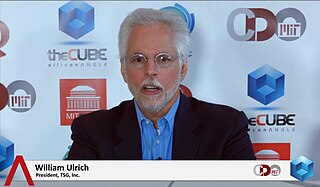Related Research Articles

Computer-aided software engineering (CASE) was a domain of software tools used to design and implement applications. CASE tools were similar to and were partly inspired by Computer-Aided Design (CAD) tools used for designing hardware products. CASE tools were intended to help develop high-quality, defect-free, and maintainable software. CASE software was often associated with methods for the development of information systems together with automated tools that could be used in the software development process.

Edward Nash Yourdon was an American software engineer, computer consultant, author and lecturer, and software engineering methodology pioneer. He was one of the lead developers of the structured analysis techniques of the 1970s and a co-developer of both the Yourdon/Whitehead method for object-oriented analysis/design in the late 1980s and the Coad/Yourdon methodology for object-oriented analysis/design in the 1990s.
A data-flow diagram is a way of representing a flow of data through a process or a system. The DFD also provides information about the outputs and inputs of each entity and the process itself. A data-flow diagram has no control flow — there are no decision rules and no loops. Specific operations based on the data can be represented by a flowchart.
Enterprise architecture (EA) is a business function concerned with the structures and behaviours of a business, especially business roles and processes that create and use business data. The international definition according to the Federation of Enterprise Architecture Professional Organizations is "a well-defined practice for conducting enterprise analysis, design, planning, and implementation, using a comprehensive approach at all times, for the successful development and execution of strategy. Enterprise architecture applies architecture principles and practices to guide organizations through the business, information, process, and technology changes necessary to execute their strategies. These practices utilize the various aspects of an enterprise to identify, motivate, and achieve these changes."
Competitive intelligence (CI) is the process and forward-looking practices used in producing knowledge about the competitive environment to improve organizational performance. It involves the systematic collection and analysis of information from multiple sources, and a coordinated CI program. It is the action of defining, gathering, analyzing, and distributing intelligence about products, customers, competitors, and any aspect of the environment needed to support executives and managers in strategic decision making for an organization.
Albert F. Case Jr. is an American software engineer and one of the leaders in the development of computer-aided software engineering (CASE) technologies and system development methodologies.

Decline and Fall of the American Programmer is a book written by Edward Yourdon in 1992. It was addressed to American programmers and software organizations of the 1990s, warning that they were about to be driven out of business by programmers in other countries who could produce software more cheaply and with higher quality. Yourdon claimed that American software organizations could only retain their edge by using technologies such as ones he described in the book. Yourdon gave examples of how non-American—specifically Indian and Japanese—companies were making use of these technologies to produce high-quality software.

Larry LeRoy Constantine is an American software engineer, professor in the Center for Exact Sciences and Engineering at the University of Madeira Portugal, and considered one of the pioneers of computing. He has contributed numerous concepts and techniques forming the foundations of modern practice in software engineering and applications design and development.

In software engineering, structured analysis (SA) and structured design (SD) are methods for analyzing business requirements and developing specifications for converting practices into computer programs, hardware configurations, and related manual procedures.
Cutter Consortium, founded by Karen Fine Coburn in 1986, is an information technology research company based in Arlington, Massachusetts.
Stephen J. Mellor is an American computer scientist, developer of the Ward–Mellor method for real-time computing, the Shlaer–Mellor method, and Executable UML, and signatory to the Agile Manifesto.
Dr. David Gelperin chaired the working groups developing the IEEE 829-1989 software testing documentation standard. With Jerry E. Durant he went on to develop the High Impact Inspection Technology that builds upon traditional inspections but utilizes a test driven additive.
Nereu Florencio "Ned" Kock is a Brazilian-American philosopher. He is a Texas A&M Regents Professor of Information Systems at Texas A&M International University.

A structure chart (SC) in software engineering and organizational theory is a chart which shows the breakdown of a system to its lowest manageable levels. They are used in structured programming to arrange program modules into a tree. Each module is represented by a box, which contains the module's name. The tree structure visualizes the relationships between modules.
Roelf Johannes (Roel) Wieringa is a Dutch computer scientist who was a Professor of Information Systems at the University of Twente, specialized in the "integration of formal and informal specification and design techniques".
Kenneth T. Orr was an American software engineer, executive and consultant, known for his contributions in the field of software engineering to structured analysis and with the Warnier/Orr diagram.

William M. Ulrich is an American business architecture consultant, consultant at Cutter Consortium, director and lecturer, known for development of 'The Systems Redevelopment Methodology' (TSRM) in the 1990s, on legacy systems in the 2000s and more recently on his work on business architecture.
Christopher P. (Chris) Gane was a British/American computer scientist, consultant and information technology writer, known for developing data flow diagrams with Trish Sarson in the 1970s.

Trish Sarson is a British/American computer scientist, consultant and information technology writer, known for developing data flow diagrams with Chris Gane in the 1970s.
Essential systems analysis was a new methodology for software specification published in 1984 by Stephen M. McMenamin and John F. Palmer for performing structured systems analysis based on the concept of event partitioning.
References
- ↑ "Cutter Business Technology Journal - the Journal of Information Technology Management." Journal of Technology. NewsRX. 14 September 2010.
- 1 2 3 "About Cutter IT Journal" (PDF). Cutter IT Journal. Retrieved 3 December 2015.